
Fast, affordable Internet access for all.
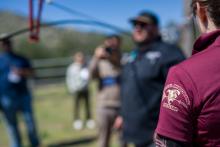
TBB11 marked an exciting development for the Tribal Broadband Bootcamps.
For this latest and newest iteration, TBB co-founder Matt Rantanen graciously permitted TBB to make a permanent fiber ring installation on his property, RantanenTown Ranch, last month. While TBB will continue to host bootcamps in partnership with Tribes in different regions of North America, the launch of this permanent broadband practice arena allows TBB to chart a new path towards even more in-depth and hands-on training.
Here is a photo-filled look at the many days of prep and three days of immersive programming that went into making it happen.
“Just the fact that we saw the fiber model in its open aspect with all the drama and issues right in front of us; my friends is the best learning methodology!” – TBB 11 Attendee
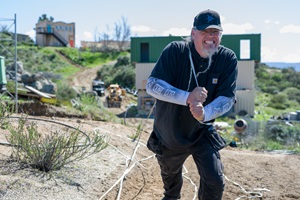
Ready or Not
Of course, building an entire, operating fiber network across RantanenTown Ranch was a massive undertaking that involved a lot of prep work.
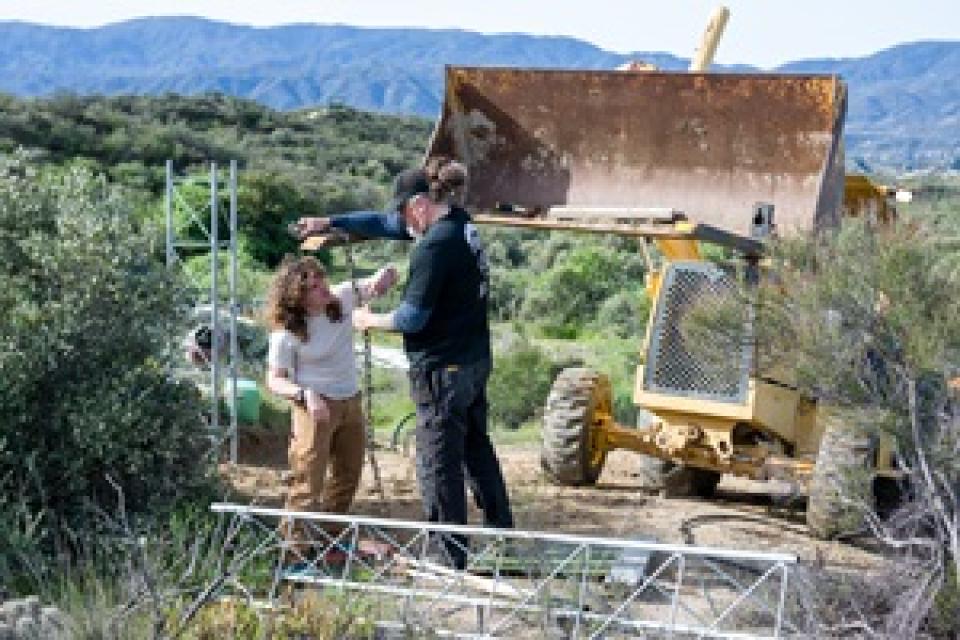

The days leading up to the bootcamp were long and intense. After trenching and laying 1,000 feet of conduit, TBB organizers manually pulled fiber through to each connection point.
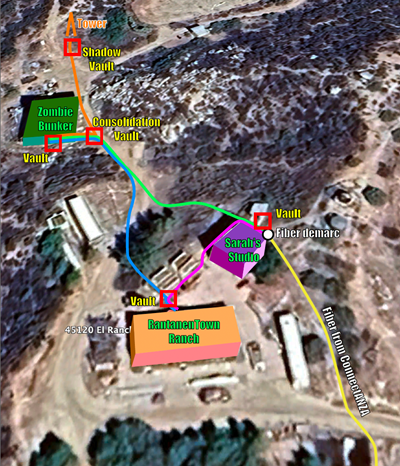
Participants dressed 48-count fiber, prepared splice cases at three main connection nodes, and installed a tower for a fiber-fed wireless point-to-point shot across the property.
A map of the fiber network – 1,000 feet of conduit, five vaults, one tower, tons of fun. And there was enough fiber (1,700 feet) to complete the planned network, with a little extra for demonstration purposes and plenty of slack loops for future connections. (Special thanks to AFL for providing the 48-count armored fiber).
Cheyenne River Sioux Tribe Telephone Authority to the Rescue
Laying out the network was only half the battle – organizers still needed to splice the different fiber runs together and connect the interior electronics at four different locations.
Nick from Merit Network put in a heavy lift to get the fiber runs going.
Luckily, Mario and Jared are experienced technicians from Cheyenne River Sioux Tribe Telephone Authority (CRSTTA) and were willing to show up early to lend their expertise.

Jared jumped in with a new-to-him splicer to connect the drop inside Matt’s workshop - affectionately called the Zombie Bunker.

Mario made essential connections for the network at the main aggregation point, demonstrating his real-world skills in both splicing and organizing a splice case.
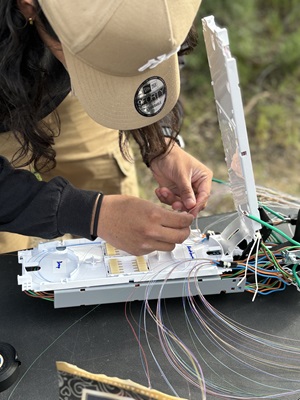
When all was said and done, RantanenTown Ranch was mostly ready for the arrival of the rest of the attendees.
It was go time.
Getting to Know the Network...and Each Other
TBB11 marked the third time “Fiber Community Theater” was featured, originally developed by Calix as an introduction to fiber networks.

In this activity, attendees stand in for major elements of a fiber-to-the-home (FTTH) network – the ONT, the distribution fiber, the drop fiber, etc.
This activity gives folks an amazing view into the flow of information through the physical and electronic landscape of a fiber network and the role each element plays in getting home users connected. It has become a favorite at TBB, among new learners and more experienced folks alike.
“I really enjoyed starting the day with the fiber theater, I think it helped refresh how the networks work and for those that I spoke with that had no idea about wireless or fiber it was a good starter.” – TBB 11 Attendee

Next up was a tour of the network. Jared and Mario from Cheyenne River Sioux Tribe Telephone Authority (CRSTTA) again stepped up, this time to explain what was happening at one of the central nodes.
Mario walked folks through how and why a splice is performed and explained some of the complexities involved in splicing in the field.
One thing to note is the importance of having a clean working environment for splicing, typically done in a trailer or truck, as Mario and Jared explained.
“Loved the splicing with Mario and Jared!” – TBB11 attendee from newer Tribal ISP


Attendees were also able to practice some techniques for clearing conduit for fiber (if there is existing infrastructure like old coax cable) and pulling fiber through. This was one of the most popular activities.
Participants got to use the plastic bag/parachute trick, mule tape, and their own strength to install a drop fiber to the “Arena” - the site of the “classroom” tent and TBB home base - as well as pull an ethernet cable through conduit uphill about 200 feet.
Throughout the event, hands-on and group activities were interspersed with group discussions on topics ranging from grants, network costs, and Tribal sovereignty. These discussions create an opportunity for a different type of knowledge-sharing and have proven essential for folks to get a holistic view of what it takes to build a Tribal ISP.
Participants’ varied expertise and perspectives made for lucrative conversations. For instance, Monica from AMERIND Critical Infrastructure (pictured) shared some of her experience as a grant writer and project manager for Tribal broadband projects across the country.
Aerial Fiber Up Close and Personal
Because attendees were dealing with a variety of terrains and environments, it was important to demonstrate both underground and aerial building techniques.
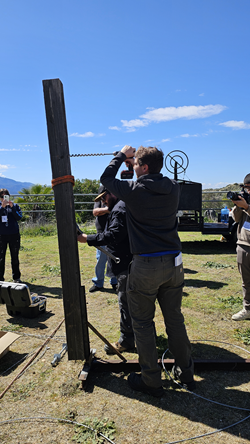
Local electric cooperative turned broadband provider Connect Anza came in with a huge assist, lending a hand with materials and setup before coming back for an aerial fiber demonstration.
They were able to offer an eye-level view of the installation thanks to a makeshift aerial pole set-up built by Matt.
First thing first, Natia from Acorn Wireless/Hoopa Valley Public Utilities District volunteered to help with the installation of the anchor bolts for each post.
Then Shawn from Connect Anza demonstrated the preparation of the steel strand that is used to support the fiber on the span between poles.
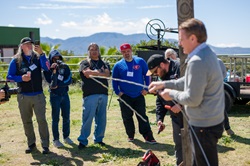
Once the support cable was up, fiber was strung and a lashing machine was used to essentially tie the fiber optic cable to the strand.

Attendee Kyle from the Karuk Tribe’s IT Department watched as Donald from Connect Anza pulled the lashing machine along the length of the span.
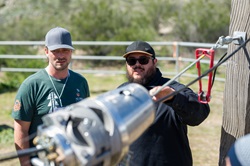
Technicians in attendance who may have to deploy aerially in their upcoming builds were particularly riveted by the demo.
Natia and Dylon from Acorn Wireless/Hoopa Valley Public Utilities District took some time afterwards to pick Donald’s brain about aerial installation techniques, challenges, and benefits.
Adventures in Troubleshooting
Perhaps the biggest benefit of developing this active fiber network are the opportunities it presents for folks to gain hands-on troubleshooting experience. And this theory was tested right away!

Participants benefited from planned activities around fiber cleaning and using troubleshooting and measurement tools.
Mario helped demonstrate the use of a scope and a cleaner to participant Cathie from Bear River Band of Rohnerville Rancheriawhile Jared answered questions from Troy, of Chickahominy Indian Tribe.
Elsewhere, Bob from Merit Networks showed off the use of an OTDR.
Beside the planned activities, though, TBB participants and organizers ended up having to actually troubleshoot the network.
The connection from one end of the network to the other wasn’t behaving right and a fix was needed. Many participants jumped at the chance to participate in an unscripted, real-life troubleshooting session.
They used a visual fault locator to determine if and where there was light loss. They tested each juncture one by one. Finally, setting a beam of light to shoot through the fiber towards the connection to the backhaul, they opened the last splice case with bated breath...

And found light leaking out of a kinked wire in the splice case at the head of the network!
A collective sigh. And a second later, five phones pulled out to take a photo of the culprit. Then it was right to work to fix the problem.
Here was proof of concept.
“I learned more in this boot camp than any of my other trainings because I was able to get hands on with the fiber and troubleshoot.” - TBB 11 Participant
Though this detour was unplanned, TBB expects to incorporate more and varied scheduled troubleshooting activities moving forward in hopes of recapturing the magic of this impromptu learning opportunity.
Jemez Pueblo Tribal Network Shows Out
Another highlight of the event was the arrival of the team from Jemez Pueblo Tribal Network (JNET), with their own toys in tow.
Currently operating as a Wireless Internet Service Provider (WISP), JNET is about to embark on a community-wide fiber-to-the-home build.

Though they’d purchased a suite of fiber tools, their vendor had not yet come through with the promised training on most of them.
The team asked if they could bring their tools with them and get hands-on practice, and it turned out to be an inspired choice!
Many of the experienced attendees and trainers were wowed with some JNET’s tools. Together, they all explored how to maximize the use of each tool in building and troubleshooting a fiber network. What made it lucky for TBB was that the JNET crew were ready to be teachers as well as learners.
Along with some of their never-been-used troubleshooting tools, JNET also brought their state-of-the-art fusion splice machine, which was one of the few tools that they had been able to get some practice with. They were excited to share that with other attendees and instructors.
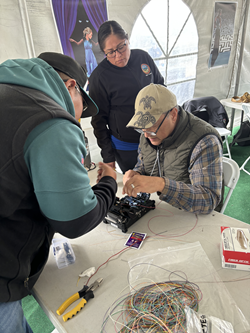

Everyone has something to learn, and everyone something to teach. JNET tech and Digital Navigator Jordan taught Nick from Merit Networks (with decades of experience in broadband) what their splicer can do.
JNET’s Network Supervisor Ange and Jordan even enthusiastically jumped in to take charge of the splicing at one of the main nodes to bring the interior electronic equipment online. Working as a team, they learned a new splice case, made a dozen connections, and even found time to teach other attendees as they went.
“Watching the fellas and Angie get things done in a way that learning was not a task or chore but a delight” - TBB 11 Attendee
Attendees were so impressed with their expertise that Ange and Jordan also became the featured splicing teachers in TBB11’s individual hands-on splice experience.
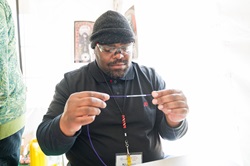
They were a set of happy students after their first-ever successful fiber splice, including Troy from Chickahominy Indian Tribe; Nartel, a brand new tech with Karuk Tribe’s ISP, Áan Chúuphan; and Cathie and her colleagues Edwin and Andy from Bear River Band.
Feeding Wireless with Fiber
Spread across two days, the last major element of TBB11’s three-day agenda involved building a wireless point-to-point connection from a tower fed by fiber.

Before climbing a ladder to install a wireless radio, the team tested the connection that was being received at the tower via fiber.
Troy plugged his phone directly into the ONT to test the quality and speed of the connection. Troy was then joined by Josephine from the Colorado River Indian Tribes, Kyle from Karuk Tribe, and Esther Jang, one of our wireless instructors.
Together they worked on troubleshooting the fiber-wireless connection and learning the background they would need to configure the wireless network the following day.
Bright and early the next day, Edwin went vertical to install the wireless radio on the tower. In the distance is the gazebo where the signal would be received.
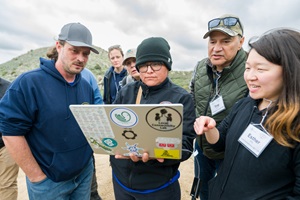
While Edwin climbed, other members of the crew made the hike to the gazebo and installed the receiver.
Walkies were used to coordinate between the two teams and fine tune the positioning between the radios.
On the tower side, Esther, Troy, and Megan monitor the signal between the two wireless radios.
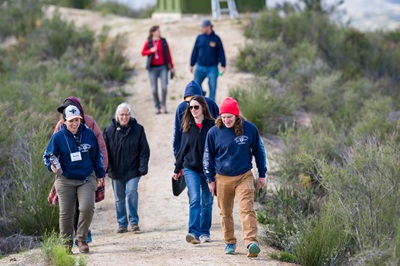
Success!
Speed tests run off the receiving radio reached nearly 1 Gbps, showing the power that wireless connectivity can have for communities who want to stretch the range of a fiber network, connect to remote locations, or design a wireless-first solution.
TBB 11 - an experiment in in-depth training for tribal networks - was a resounding success. We look forward to returning soon to this broadband playground for another round. Next time will offer an even more immersive experience.
All images courtesy of Christopher Mitchell
